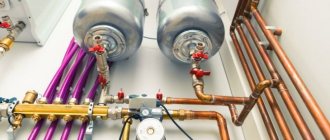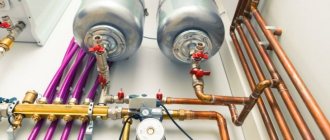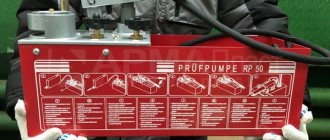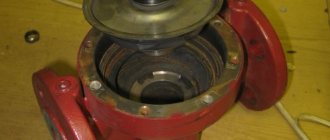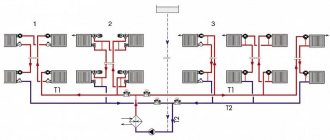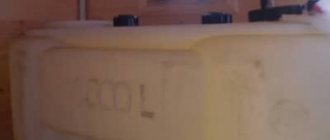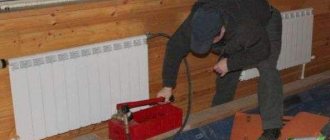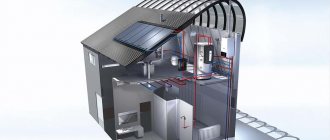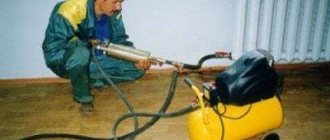In the autumn-winter season, one of the most important household tasks is the maintenance of the heating system to ensure its continued uninterrupted operation. For this purpose, so-called pressure testing is carried out - testing the strength of the pipeline and the equipment connected to it using a hydraulic or pneumatic method. This procedure is necessary both in apartment buildings with a centralized heating system and in private mansions.
To find out how to carry out pressure testing of a heating system, you can contact specialists, but the description below will allow you to do without their help - accurate implementation of the recommendations guarantees that you will obtain the same result as with the participation of a specialist.
What is pressure testing of heating and water supply systems?
Heating and water supply are two systems consisting of a large number of varied equipment. As you know, the performance of any multicomponent system is determined by the weakest element - if it fails, it stops completely or partially. To identify all weak points, pressure testing of heating and water supply is carried out. In simple terms, the pressure deliberately rises much higher than the working one, pumping liquid. This is done using special equipment; the pressure is controlled using a pressure gauge. The second name for crimping is hydraulic testing. It's probably clear why.
Heating pressure testing is carried out after any repair or before the heating season
When a heating system is pressure tested, the pressure is increased by 25-80% depending on the type of pipes, radiators, and other equipment. It is clear that such a test reveals all the weak points - everything that does not have a safety margin breaks, leaks appear in worn pipes and unreliable connections. Having eliminated all identified problems, we ensure the functionality of our heating or water supply for some time.
If we are talking about centralized heating, then pressure testing is usually carried out immediately after the end of the season. In this case, there is a decent period of time for repairs. But this is not the only case when such events are held. Pressure testing still takes place after repairs or replacement of any element. In principle, this is understandable - we need to check how reliable the new equipment and connections are. For example, you soldered heating from polypropylene pipes. We need to check how high quality the connections are. This can be done using crimping.
If we talk about autonomous systems in private houses or apartments, then a new or repaired water supply is usually checked simply by turning on the water, although even here a strength test would not hurt. But it is advisable to test the heating “to its fullest”, both before commissioning and after repairs. Keep in mind that those pipelines that are hidden in walls, floors or suspended ceilings must be tested before they are closed. Otherwise, if during testing it turns out that there are leaks there, you will have to disassemble/break everything and fix the problems. Few people will be happy about this.
Which jack to choose
For the manufacture of a press from a jack, single-rod bottle-type devices are optimally suited, which are distinguished by a simple design and high reliability. Presses made on the basis of such a jack have higher power when compared with equipment whose main working body is lever, crank, screw or eccentric mechanisms.
Press with hydraulic jack
Various models of hydraulic jacks are capable of creating a force, the value of which varies in the range from two to one hundred tons, which allows them to be used as a very effective power mechanism.
Hydraulic jacks, along with high power, are distinguished by fairly compact dimensions, which allows them to be used for the manufacture of presses that will not take up much space in a workshop or garage, but at the same time will be highly efficient.
Equipment and test frequency
Pressure testing of centralized systems is carried out by personnel using standard equipment, so it is hardly worth talking about. But not everyone probably knows about the costs of private heating and water supply. These are special pumps. There are two types - manual and electric (automatic). Manual pressure testing pumps are autonomous, the pressure is pumped up using a lever, and the created pressure is controlled using a pressure gauge built into the device. Such pumps can be used for small systems - pumping is quite difficult.
Manual crimping machine
Electric pumps for pressure testing are more complex and expensive equipment. They usually have the ability to create a certain pressure. It is set by the operator, and it is “caught up” automatically. Such equipment is purchased by companies engaged in professional crimping.
According to SNiP, hydraulic testing of heating systems must be carried out annually, before the start of the heating season. This applies to private houses too, but few people comply with this standard. At best, they check it once every 5-7 years. If you are not going to test your heating annually, then there is no point in buying a pressure tester. The cheapest manual one costs about $150, and a good one costs from $250. In principle, you can rent it (usually from companies that sell components for heating systems or from offices that rent equipment). The amount will be small - you need the device for several hours. So this is a good solution.
Additional settings
When using a homemade hydraulic press, users often have a question about how to make the jack rod move a shorter distance. This will allow you to spend less time processing parts using a homemade press. There are several ways to solve this problem.
- A rectangular or square profile pipe is mounted on the lower fixed stop of the press (either a removable version or fixation using a welded joint is possible).
- A height-adjustable lower stop is installed on the press, which is fixed to the side posts of the device with bolts. To install such a stop at different levels, holes are made in the side posts of the press at the required height.
- The distance between the press stops can also be reduced by using replaceable pads or anvils installed on the surface of the lower stop of the equipment.
Source: met-all.org
Call specialists or do it yourself
If for some purpose you require a pressure test certificate for your heating or hot water supply system, you have only one option - order this service from a specialized organization. The cost of heating pressure testing can only be quoted to you individually. It depends on the volume of the system, its structure, the presence of shut-off valves and their condition. In general, the cost is calculated based on the tariff for 1 hour of work, and it ranges from 1000 rubles/hour to 2500 rubles/hour. You will have to call different organizations and inquire with them.
Companies involved in hydraulic system testing have more professional equipment.
If you have upgraded the heating or hot water supply of your own home, and you know for sure that your pipes and equipment are in good condition, there are no salts or deposits in them, you can carry out pressure testing yourself. No one will demand hydraulic test certificates from you. Even if you see that your pipes and radiators are clogged, you can wash everything yourself and then test it again. If you just don’t want to do this, you can call specialists. They will immediately clean the system and pressure test it, and will also issue you a certificate.
Certificate of hydrostatic testing of the system (pressure testing)
FakeHeader
Comments 71
Calculate the design according to strength of material - 10t is the limit... Not enough, although it’s unlikely that more is needed in the garage.
My friend, what do you use to drown the batteries in the garage?
At that time, everything was heated by the working furnace with a mini-boiler. and now everything is disassembled and awaiting installation in the box
Please tell me which channel you used? but it will be good if you help with the size of your press, not only to me but also to other participants, I will be very grateful for the drawing
unfortunately, all the dimensions were from my head - I didn’t draw anything, I just adjusted it according to the availability of material.
I can only write what I remember: in the first photo on one stand it says L - 2330, I bought it in addition, as far as I remember, this is the height of the press, the width of the table is 270 mm, the length of the legs is 1000 mm, the width is 530 mm. and when marking the holes, I started from the posts - I made a line in the center of the ends, and then oriented all the other holes along it.
channel 16 for racks, channel 12 for cross beams and for the table, channel 10 for the press platform and channel 7 for legs + M30 bolts
thank you =))) we will buy the material and try it))) now is the time to create a drawing based on the finished tool))
Crimping process
Pressure testing of heating systems in a private home begins with disconnecting the heating boiler, automatic air vents and expansion tank from the system. If there are shut-off valves leading to this equipment, you can close them, but if the valves turn out to be faulty, the expansion tank will definitely fail, and the boiler will fail, depending on the pressure that you apply to it. Therefore, it is better to remove the expansion tank, especially since this is not difficult to do, but in the case of a boiler, you will have to rely on the serviceability of the taps. If there are thermostats on the radiators, it is also advisable to remove them - they are not designed for high pressure.
Sometimes not all heating is tested, but only some part. If possible, it is cut off using shut-off valves or temporary jumpers are installed - surges.
There are two important points: pressure testing can be carried out at an air temperature of no lower than +5°C, the system is filled with water with a temperature no higher than +45°C.
The following is the process:
- If the system has been in operation, the coolant is drained.
- A crimping machine is connected to the system. A hose extends from it, ending with a union nut. This hose is connected to the system in any suitable place, even in the place of the removed expansion tank or instead of the drain valve.
- Water is poured into the container of the pressure testing pump and pumped into the system using the pump.
The device is connected to any available input - on the supply or return pipeline - it doesn’t matter
- Before increasing the pressure, all air must be removed from the system. To do this, you can bleed the system a little with the drain valve open or drain it through air vents on the radiators (Mayevsky valves).
- The system is brought to operating pressure and held for at least 10 minutes. During this time, all remaining air is released.
- The pressure is raised to the test pressure and maintained for a certain period of time (regulated by the Ministry of Energy standards). During the test, all devices and connections are checked. They are inspected for leaks. Moreover, even a slightly damp connection is considered a leak (fogging also needs to be eliminated).
- During crimping, the pressure level is monitored. If during the test its fall does not exceed the norm (as specified in SNiP), the system is considered to be in good working order. If the pressure drops even slightly below normal, you need to look for a leak, fix it, then start pressure testing again.
As already mentioned, the testing pressure depends on the type of equipment and system being tested (heating or hot water supply). The recommendations of the Ministry of Energy set out in the “Rules for the technical operation of thermal power plants” (clause 9.2.13) are summarized in a table for ease of use.
Table of equipment under test
Please note that for testing heating and plumbing made of plastic pipes, the test pressure holding time is 30 minutes. If no deviations are detected during this time, the system is considered to have successfully passed the pressure test. But the test continues for another 2 hours. And during this time, the pressure drop in the system should not exceed the norm - 0.02 MPa (0.2 kgf/cm²).
Correspondence table for different units of pressure measurement
On the other hand, SNIP 3.05.01-85 (clause 4.6) has other recommendations:
- Heating and water supply systems are tested at a pressure of 1.5 times the working pressure, but not lower than 0.2 MPa (2 kgf/cm²).
- The system is considered operational if after 5 minutes the pressure drop does not exceed 0.02 MPa (0.2 kgf/cm).
What standards to use is an interesting question. For now, both documents are valid and there is no certainty, so both are valid. It is necessary to approach each case individually, taking into account the maximum pressure for which its elements are designed. So the working pressure of cast iron radiators is no more than 6 Atm, respectively, the test pressure will be 9-10 Atm. It’s also worth deciding on all the other components in approximately the same way.
The main element of a homemade press
Why is a hydraulic jack used to make homemade presses? This is due to the operating principle of such a device, based on one of the fundamental laws of physics. According to this law, a liquid, unlike a gas, does not compress under the influence of pressure and, accordingly, does not reduce its volume. A hydraulic jack makes it possible to transfer the force applied by the user of such a device to the object to be processed without loss of power.
The design of a hydraulic jack consists of two cylinders and pistons of different diameters. It is designed in such a way that the force created by the device on its working element is much greater than that which the user of such a device applies to its control element. This allows the use of hydraulic jacks to lift loads of even very significant weight, and in cases where such a device is installed on a hydraulic press, to create with its help a large compression force. It is also important that the efficiency of hydraulic jacks can reach up to 80%, which is a very good indicator.
Portable press device with a lower jack position
Meanwhile, if you decide to make your own press based on a hydraulic jack, take into account the disadvantages that lifting devices of this type have. The most serious disadvantage of a hydraulic jack is that when using it, it is impossible to accurately determine the height to which the rod of such a device is lowered. If this drawback is not particularly critical when lifting a load, then when using a hydraulic jack as the main working body of the press, after each working cycle the pressure in the jack chamber must be released in order to then re-approach the rod of the device to the workpiece.
Air crimping
Not everywhere and not always is it possible to rent a crimping machine, just as it is not possible to buy one. For example, you need to test the heating in your dacha. The equipment is specific and the chances that someone you know has it is very low. In this case, pressure testing of the heating system is carried out with air. To pump it, you can use any compressor, even a car one. The pressure is monitored using a connected pressure gauge.
This type of crimping is less convenient and not entirely correct. Heating and plumbing are designed to transport liquids, which are much denser than air. Where water will not even ooze out, air will escape. Therefore, we can say with a high degree of confidence that you will have an air leak - somewhere there will be a loose connection. Moreover, it is difficult to determine the location of the leak during such testing. For this purpose, use a soap solution, which coats all joints and connections, all places where air can escape. Bubbles appear at the leak site. Sometimes you have to search for a long time. This is precisely why such pressure testing of the heating system is not very popular.
Pressure testing of a heated floor has its own characteristics - you must first check the comb and all the devices attached to it. To do this, close all the supply and return valves of the loops, filling only the heated floor manifold, and check it by raising the pressure. Having reset it to normal, the heated floor loops are filled one by one, and only then is excess pressure created. The process is described in more detail in the video.
Sequencing
Having decided to make a hydraulic press with your own hands, pay special attention not only to the choice of the jack with which such a device will be equipped, but also to the manufacture of a strong supporting structure. It must be understood that the same forces are exerted on the press platform as on the workpiece being processed, therefore this assembly of a homemade pressing device must have very high strength. Otherwise, it will collapse after a short period of use.
To make a platform for a hydraulic press with your own hands, which will be highly durable and rigid, you should use thick-walled U-shaped profiles. Profiled rolled products of square or rectangular cross-section are also suitable for this. To create a platform for a hydraulic press, you will need 4 pieces of a U-shaped profile or profile pipe, the lengths of which must correspond to the drawing. Sections of profile pipes or profiles prepared for the press platform are welded to each other on their sides, and the welds are made on all sides of the joint being created, which will provide the manufactured structure with the required rigidity.
Before welding, the parts are placed in place and secured with clamps.
After the press platform is completely ready, you can begin to create the lower stop and vertical posts of the device, for which a profile pipe is used. When selecting blanks for the vertical stands of the press, it is necessary to take into account that their length should be equal to the sum of the height of the jack body, the largest output of its rod and the thickness of the future removable stop. For the lower stop, a section of profile pipe is prepared, equal in length to the support platform.
Bolting workpieces together
The press platform, its vertical posts and the lower stop are welded into a single frame structure, and it is important to ensure that a right angle is strictly maintained between the joined elements. To make the assembled press frame structure more rigid and resistant to loads, it should be strengthened using metal plates that are welded diagonally to the side posts and the press platform.
Assembling the upper part of the frame
To make the jack press operational, it must be equipped with a removable stop, which, moving vertically along special guides, will exert pressure on the part being processed. Such a structural element of the press is made from several metal plates more than 10 mm thick, which are assembled into a block and welded together on both sides. The length of the plates from which the removable press stop is made should be slightly less than the distance between the side posts of the device.
